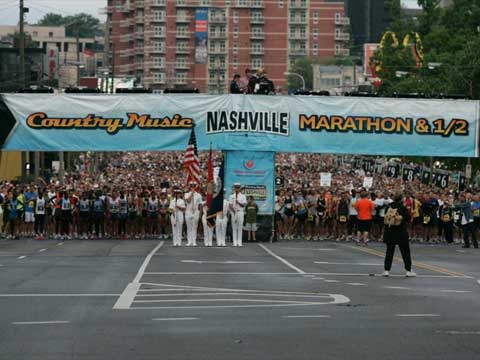Rock ‘n’ Roll Nashville Marathon Training Tips!
Rock ‘n’ Roll Nashville Marathon: Run to the music, listen to your body


Goals of weight loss, physical fitness, personal records (PRs), and race completion lead many of us to lace up the old sneakers before the late April race begins. Whether you are a beginner, intermediate, or seasoned veteran of the art of racing, many challenges and obstacles can arise during the next few months. Your main objective is to achieve your goal without temporarily or permanently damaging your body.
State your goal: write it down, tell others, put it on the fridge, and pay for the race early. All of these motivational tips can help you keep your eye on the prize (in this case, the technical tee and the finishers medal). Writing and reviewing realistic and obtainable goals leads to the satisfaction and completion of those goals.
Training plans: there are many out there based on your intended goal whether it is just finishing or setting a PR. In general, plans range from 10-16 weeks depending on the race distance you choose. 3, 4, 5, and 6 day-a-week plans are available from experience levels beginner to pro. Magazines such as Runners World and numerous online websites provide such training plans. These plans can be easily developed to meet your needs and imported into your daily calendar.
Gear: shoes and socks and tees, oh my. Running is the objective here, but some very helpful items get us from point A to point B. Spike Lee used to say “It’s gotta be the shoes”. Well, he was partly right. The most common mistake beginning runners make is bargain shopping for inexpensive shoes. Since our feet or, in this case, our shoes are the first line of defense against injury, proper fit and functionality are important. Many local specialty shoe stores employ knowledgeable salespeople to help find the shoe best suited for you. Motion control vs. cushioned vs. stability are the most popular features available. Since most races prohibit streaking and the CMM is no exception, proper training/race attire is required and welcomed. Socks, shorts/shirts, and some other key accessories can be vital in our racing/training success. Performance gear comes in all sizes, styles, and materials. The most popular and beneficial gear contains some sort of moisture-wicking fabric. Since wet garments generally cling and chafe, choosing an outfit that breathes can make your run more pleasurable. Since CMM training will encompass the late winter to early spring seasons, knowing what to wear and when to wear it is important. Remember the 20-degree rule when training: always dress as if the temperature is 20 degrees warmer than the actual temperature. The body will generally heat up within the first one to two miles. This will prevent you from carrying unwanted clothing throughout your run or from ditching it to pick it up later.
Nutrition: Fuel! You are expecting your body to perform well so you should put some thought into what you put in it. Eating right is an important part of running so having some knowledge of nutrition can have a dramatic effect on your running performance. Carbs, carbs, carbs, load up! During training, it is necessary to build up your glycogen stores. By increasing carbohydrate consumption in our daily meals, it may be possible to avoid hitting the dreaded “wall”. This is the moment during training or racing (usually after about 45 minutes) in which the body’s blood glycogen is depleted. This “wall” can be avoided by consuming carb-rich snacks such as energy bars and gels before and during your run. This is no time to be on a carb diet. Hydration is another key element to running half and full marathons. With April temperatures often climbing into the 70’s and 80’s, dehydration can become a serious issue. Usually, 6-8 oz water or sports drink every 20+ minutes will keep you in the clear. Hydration belts are useful for training, and hydration tables will be available during the race. Remember that stuff running down your face isn’t sweat…it’s liquid awesome.
Injury recognition/prevention: Green for go, red means stop. How do I know when I shouldn’t continue or if I need to ask for help? By now, you have spent a lot of time on the roads and getting to know your body. So, what are some warning signs that things are going south?
Any discomfort in the chest area or pain/numbness/tingling in the arms, neck, or jaw may indicate a heart attack. STOP running and seek immediate medical attention!
Nausea, dizziness, or lightheadedness? STOP running!
Difficulty breathing? STOP running!
Pain in a joint or muscle that is forcing you to alter your stride? Stop and stretch. If pain persists, STOP running.
Being chased by a grizzly bear…disregard previous answers and KEEP RUNNING.
If you have set realistic and obtainable goals for yourself then you are already on your way. Give yourself a chance, relax, and enjoy the music.
“Each step takes you closer to your goal”
